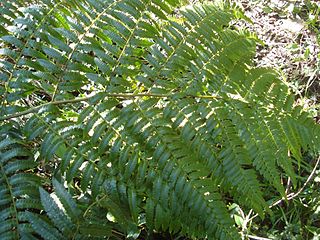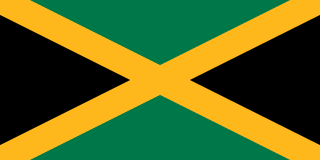Cyathea affinis is a variable species of tree fern native to Fiji, Samoa, the Cook Islands, Austral Islands, Tahiti, and the Marquesas Islands. The trunk of this plant is erect and 2–6 m tall. Fronds are bipinnate and 2–3 m in length. The rachis and stipe are pale to brown in colour, or flushed with red towards the pinnule rachis. The stipe is sparsely covered in narrow basal scales, which are pale to dark and have broad fragile edges. Characteristically of this species, the lowest one or two pairs of pinnae may be slightly reduced and occur towards the base of the stipe. Sori are located near the pinnule midvein and are partially or fully covered by indusia, which open towards the pinnule margin.
Cyathea balanocarpa is a species of tree fern native to Cuba, Jamaica and Hispaniola. Despite its wide distribution, little is known about this species. It is apparently of hybrid origin.
Cyathea brooksii is a species of tree fern native to Cuba, Hispaniola and Puerto Rico, where it grows on serpentine soils in shaded ravines, along streams, and on forested slopese at an altitude of 250–950 m. The trunk is prostrate and only about 6 cm in diameter. Fronds are pinnate or bipinnate and up to 2 m long. The base of the rachis is covered with blackish scales that have a paler margin. Sori occur in two rows, one along each side of the pinnule midvein.
Cyathea crassa is a species of tree fern endemic to the Santo Domingo area in the Dominican Republic. Little is known about this rare tree fern.
Cyathea doctersii is a species of tree fern endemic to Sumatra, where it grows in forest at an altitude of approximately 150 m. The trunk is erect and 2–3 m tall. Fronds are bi- or tripinnate and 2–3 m long. The stipe is covered with scattered flat, brown scales and some hairs. Sori occur near the fertile pinnule midvein and are covered by thin, brown indusia that are scale-like in appearance.
Cyathea ferruginea is a species of tree fern endemic to the Philippines.
Cyathea geluensis is a species of tree fern native to central and eastern New Guinea as well as the Louisiade Archipelago, where it grows in mossy forest. In New Guinea itself, plants grow at an altitude of 1000–2000 m, however they are present at lower elevations of 700–900 m on associated islands. The trunk of this tree fern is erect and may be 5 m tall or more. Fronds are bi- or tripinnate and 1-2.5 m long. They are usually about ten live fronds present in the crown at once. The stipe may be warty and/or have short spines as well as many scattered scales towards the base. These scales are pale to dark and have dull, fragile edges. Sori occur near the fertile pinnule midvein and are protected by pale, thin indusia. C. geluensis is a variable taxon and further study is needed to determine whether it does not in fact represent a species complex.
Cyathea gigantea is a species of tree fern native to northeastern to southern India, Sri Lanka, Nepal to Myanmar, Thailand, Laos, Vietnam, the Malay Peninsula, as well as central Sumatra and western Java. It grows in moist open areas at an altitude of 600–1000 m. The trunk of this species is erect and may be as tall as 5 m or more. Fronds are bi- or tripinnate and usually 2–3 m long. The rachis is long, dark to black in colouration and rough in appearance after the fall of scales. These scales are dark brown, glossy and have a narrow paler margin and fragile edges. Sori are round and indusia absent.
Cyathea glabra is a species of tree fern native to Borneo, western Java, Sumatra and the Malay Peninsula, where it grows in lowland swamp forest and montane forest at an elevation of up to 1500 m. The trunk of this plant is erect and 2–4 m tall. Fronds are bi- or tripinnate and 1–2 m in length. Characteristically of this species, the lowest pinnae may be significantly reduced. The stipe is very dark and bears basal scales. These scales are dark, glossy and have a paler margin and fragile edges. Sori are produced in groups of one to three on fertile pinnule veins. They lack indusia.
Cyathea gleichenioides is a species of tree fern endemic to New Guinea, where it grows in open peaty grassland and on forest margins, often in groups, at an altitude of 2800–3700 m. The trunk of this plant is erect, up to 3 m tall and about 24 cm in diameter. The narrow fronds are tripinnate and about 1 m in length. Around 60 fronds form a rounded crown.The stipe is warty and bears scattered scales towards the base. These scales may be either glossy brown with a paler dull margin, or small, pale and fringed. Sori occur one or two per fertile pinnule and are protected by firm, brown indusia.
Cyathea grevilleana is a species of tree fern endemic to Jamaica, where it grows in moist gullies and on wooded hills in both calcareous and noncalcareous soils at an altitude of 200–1200 m. The trunk of this plant is erect, about 7 m tall, and 10–15 cm in diameter. It is characteristically clothed in old stipe bases, brown scales and blackish spines. Fronds are tripinnate, dark green in colour, and up to 4 m in length. The last pinnae are sometimes separated, forming a distinctive clump around the trunk apex. The rachis is yellow-brown and almost smooth. This species has a long, dark brown stipe with a few scattered spines. Sori are produced in four to six pairs along the pinnule midvein. They are protected by pale brown indusia that are cup-like in appearance.
Cyathea heterochlamydea is a little-known species of tree fern native to the islands of Luzon, Panay, Negros and Mindanao in the Philippines, where it grows in montane forest. The trunk of this plant is erect and usually up to 4 m tall or more. Fronds may be bi- or tripinnate and 1–2 m in length. The stipe is warty and/or bears short spines and scales. These scales are dark, glossy and have a narrow pale margin. Sori are borne near the fertile pinnule midvein and are protected by firm, brown indusia.

Cyathea delgadii is a widespread species of tree fern native to Costa Rica, Panama, Venezuela, French Guiana, Guyana, Trinidad, Colombia, Ecuador, Peru, Bolivia, Argentina, Paraguay, and Brazil.
Cyathea × marcescens, commonly known as the skirted tree fern, is a tree fern endemic to the Cape Otway ranges in Victoria and Tasmania, Australia. It is a natural hybrid, apparently Cyathea australis × Cyathea cunninghamii. Braggins and Large (2004) note that it has characteristics midway between these two species. The spores of C. × marcescens are usually malformed although sterile. The trunk of this plant is erect and up to 10 m tall. Fronds may be bi- or tripinnate and 3–4 m in length. Dead fronds often persist, forming a characteristic skirt around the trunk. The stipe is thick, black and warty. The rachis and trunk are covered in shiny, dark brown scales. Sori are borne near the fertile pinnule midvein and are protected by thin indusia that are saucer-like in appearance.
Cyathea imbricata is a species of tree fern endemic to Western New Guinea, where it grows in open forest at an altitude of 3240 m. The trunk of this plant is erect and approximately 2 m tall. Fronds may be bi- or tripinnate and are usually less than 1 m in length. The stipe is dark, spiny, and covered with caducous scales. These scales are glossy brown in colouration and have a paler margin and fragile edges. Sori are borne in groups of one to four per pinnule lobe. They are protected by firm indusia.
Cyathea javanica is a species of tree fern native to western Java and Sumatra, in Indonesia.
Cyathea junghuhniana is a species of tree fern native to southern and central Sumatra and western Java, where it grows in forest at an altitude of 1000–2000 m. The trunk of this species is erect and may be 2 m tall or more. Fronds are tripinnate and up to about 3 m long. The stipes of this species are persistent and form a skirt around the trunk. They are brown, spiny, and covered with glossy, dark brown scales. Sori are borne near the midvein of fertile pinnules and are protected by thin indusia.
Cyathea kermadecensis is a species of tree fern endemic to Raoul Island in the Kermadec Islands, where it is locally common in damp, and sometimes drier, forest and scrub. The trunk of this plant is erect, slender, and up to 20 m tall. It is often covered with scars of old stipe-bases. Fronds are tripinnate and up to 4 m in length. The rachis and stipe are both brown in colouration and bear basal scales that are brown, glossy, and often twisted. Sori are borne on either side of the pinnule midvein. They are covered by hood-like indusia.
Cyathea latebrosa is a common and widespread species of tree fern native to Indochina. Its natural range covers Cambodia and Thailand, and stretches from the Malay Peninsula to Indonesia, where it is present on the islands of Borneo and Sumatra. Plants reported from India and Sri Lanka have thinner indusia and may represent a separate, as-yet undescribed, species. C. latebrosa grows in a wide range of habitats, including forest, secondary forest, and plantations, from sea level up to an elevation of about 1500 m.

Cyathea smithii, commonly known as the soft tree fern or kātote, is a species of tree fern from New Zealand.





